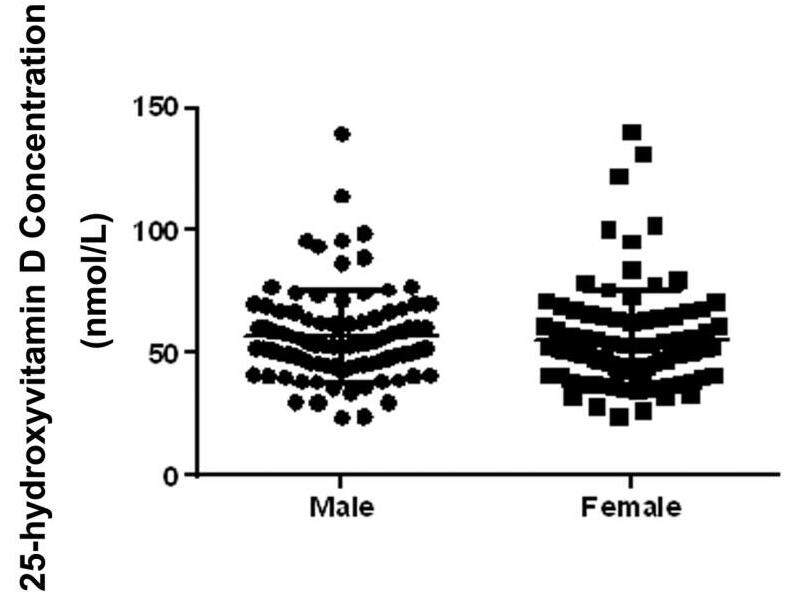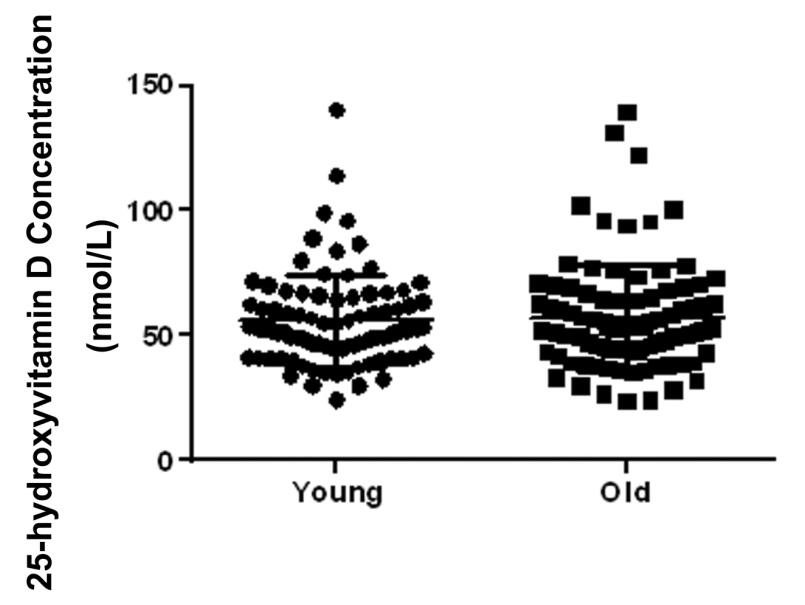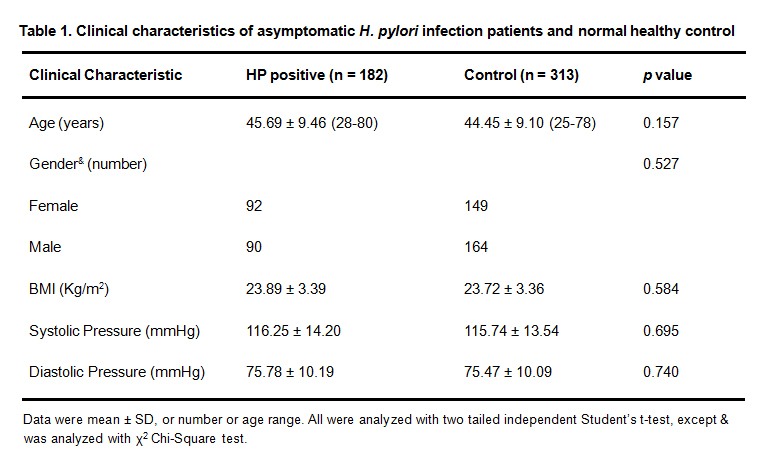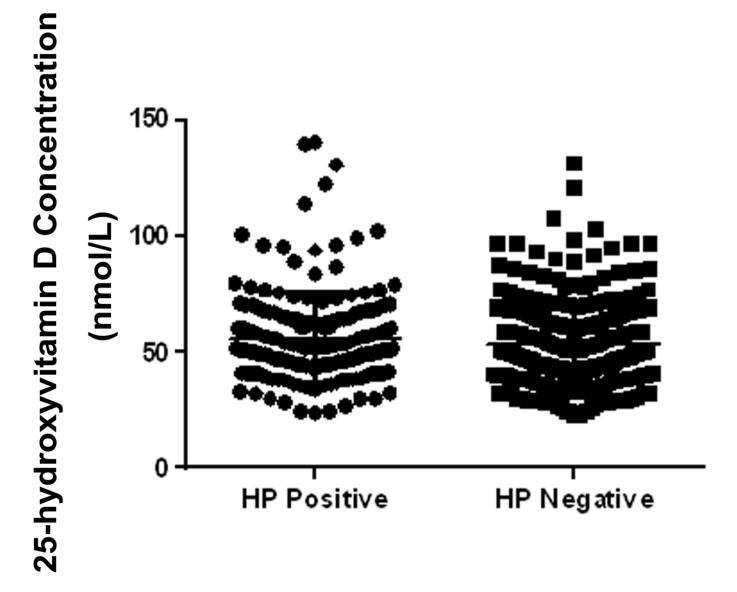Location:Home >> Detail
TOTAL VIEWS
Med One. 2017; 2: e170024. https://doi.org/10.20900/mo.20170024
1 Health Examination Center, Sun Yat-Sen Memorial Hospital, Sun Yat-Sen University, Guanzhou, Guangdong Province, People’s Republic of China
2 Biobank Department, Sun Yat-Sen Memorial Hospital, Sun Yat-Sen University, Guanzhou, Guangdong Province, People’s Republic of China
3 Department of Clinical Laboratory, Sun Yat-Sen Memorial Hospital, Sun Yat-Sen University, Guanzhou, Guangdong Province, People’s Republic of China
4 Department of Prevention and Health Care, Sun Yat-Sen Memorial Hospital, Sun Yat-Sen University, Guanzhou, Guangdong Province, People’s Republic of China
5 Department of Clinical Laboratory, Zengcheng district people’s hospital of Guangzhou, Guanzhou, Guangdong Province, People’s Republic of China
+ Equal contributors
*Corresponding authors: Jian Li, Room 316, Biobank Department, Yat-Sen Building, Sun Yat-Sen Memorial Hospital, 33 Yingfeng Road, Guangzhou 510120, China. Tel: 86-20-81332072; Fax: 86-20-81332833;
Hongyu Li, Clinical Laboratory Block, Zengcheng district people’s hospital of Guangzhou, 1 Guangming Road, Zengcheng District, Guangzhou 511300, China. Tel: 86-20-81332291; Fax: 86-20-81332833;
Background: Helicobacter pylori (H. pylori) infection is one of the most risk factors for gastric cancer. More than 80 % of H. pylori infection was demonstrated as asymptomatic infection. Vitamin D was recently found to play important roles in many diseases including infectious disease and cancer. While the level of vitamin D in asymptomatic H. pylori infection was rarely reported, so we investigated serum vitamin D concentration in asymptomatic H. pylori infection in this study.
Methods: Data for 3567 people were collected and analyzed, 182 of whom were identified as asymptomatic H. pylori infection without any other disease. H. pylori infectionstatus was determined by carbon-13 urea breath test. Serum 25-hydroxyvitamin D, was detected with ELISA. Periphery leukocyte, neutrophile and lymphocyte frequencies were detected with standard automated clinical methodologies.
Results: No significant different serum 25-hydroxyvitamin D concentration was found between asymptomatic H .pylori infection patients and normal healthy control. Asymptomatic H. pylori infection patients had significantly higher periphery leukocyte and neutrophile frequencies than those in normal healthy control.
Conclusion: Asymptomatic H. pylori infection status did not influence the concentration of circulating vitamin D.
Helicobacter pylorus (H. pylori) is a gram-negative microaerophilic bacterium that selectively colonizes in the human stomach [1]. About 50 % of the global population is infected by H. pylori [1-3]. Variable clinical manifestations are associated with H. pylori infection, and 80 % - 90 % of them are asymptomatic infection, and 10 % - 15 % of them are demonstrated as gastric or duodenal ulcer, and 1 % - 2 % of them are directly found in gastric cancer (GC) patients [4]. The World Health Organization has classified H. pylori as a type I carcinogen, as 75 % of GC is associated with H. pylori infection. As asymptomatic infection is the majority demonstration of H. pylori infection, it is necessary to study asymptomatic H. pylori infection to prevent gastric cancer.
Vitamin D is a fat-soluble secosteroid which is synthesized in the body and has broad biological effects. 25-hydroxyvitamin D is the most stable and widely measured type of vitamin D in circulating. Active vitamin D can not only regulate calcium and phosphorus homeostasis [5, 6], it has a broad range of functions including modulating the immune system and regulating cellular differentiation and proliferation [7-13]. So, vitamin D is no more just associated with skeletal diseases, it is also found to play important role in many non-skeletal chronic diseases such as cardiovascular disease, metabolic disorder, infectious disease, autoimmune disease, mortality and cancer [14-27].
Vitamin D was reported to can activate the vitamin D receptor in H. pylori infection patients to inhibit the replication of H. pylori [28]. And vitamin D concentration in H. pylori infection was reported to be different in different disease status. For example, the level of vitamin D was reported to be lower in H. pylori gastritis patients than that in healthy control in one research [29], while in another elegant study, the concentration of vitamin D was reported to have no significant difference between H. pylori positive and H. pylori negative severely obese patients [30]. The level of 25-hydroxyvitamin D in asymptomatic H. pylori infection was rarely reported, so we investigated serum concentration of 25-hydroxyvitamin D, different cancer antigens and periphery immune cell frequency in asymptomatic H. pylori infection in this investigation.
This study was approved by the Committee for Ethical Review of Research involving Human Subjects at the Sun Yat-Sen Memorial Hospital and oral consent was performed.
2.2 Study populationData about 3567 people for normal physical examination in the Sun Yat-Sen Memorial Hospital, Sun Yat-Sen University were collected and analyzed for H. pylori infection firstly, 495 of whom were further enrolled for 25-hydroxyvitamin D concentration and other parameters analysis in asymptomatic H. pylori infection related study after careful exclusion. 182 of them were identified as asymptomatic H. pylori infection without any other diseases, and remains were normal healthy H. pylori negative control.
Excluding criteria for asymptomatic H. pylori infection: People did not take carbon-13 urea breath test and did not detect serum 25-hydroxyvitamin D concentration was excluded from this investigation. People with any signs of acute infection, chronic inflammatory disease, malignancy, hypertension, diabetes mellitus, or any abnormal were excluded from this investigation.
2.3 Carbon-13 urea breath testH. pylori infection status was determined with carbon-13 urea breath test according to the instruction of the manufacturer performed with FAMci2 in the digestion laboratory of the Sun Yat-Sen Memorial Hospital.
2.4 Enzyme linked immunosorbent assays (ELISA)Serum 25-hydroxyvitamin D concentration was detected with ELISA (MK3) performed in the clinical laboratory of the Sun Yat-Sen Memorial Hospital.
2.5 Periphery immune cell frequency calculationPeriphery leukocyte, neutrophile and lymphocyte concentration was performed with Sysmex XE-5000 in the clinical laboratory of the Sun Yat-Sen Memorial Hospital.
2.6 Statistical analysisAll statistical analysis was performed with SPSS version 16.0 and significance was defined as p values less than 0.05. Continuous variables were analyzed with independent Student’s t-test (two tailed) and reported as mean ± standard deviation (SD). Category variables were compared with the Chi-Square (χ2) test.
H. pylori infection status of this population (3567) was first determined with carbon-13 urea breath test, 1325 (37.2 %) of whom were found to be infected with H. pylori. Further, we summarized H. pylori infection frequency in different age and gender groups. The result showed that 51 to 60 years old population had the highest H. pylori infection incidence in all. In which, the H. pylori infection incidence was as high as 40.4 % for female and 40.3 % for male respectively, while those younger than 21 years old groups had the lowest H. pylori infection incidence (6.7 % for female and 18.2 % for male respectively) (Fig. 1).
3.2 No different 25-hydroxyvitamin D concentration was found between female and male asymptomatic H. pylori infection patientsAs asymptomatic H. pylori infection was the majority of H. pylori infection, we further analyzed 25-hydroxyvitamin D concentration in this population. As vitamin D was reported to be associated with many diseases [14-27], most of them were excluded from further analyzed. Only 182 asymptomatic H. pylori infection patients with detected serum 25-hydroxyvitamin D concentration without any other disease were included. To explore whether serum 25-hydroxyvitamin D concentration was related to gender or not, we compared serum 25-hydroxyvitamin D concentration in female and male asymptomatic H. pylori infection patients with two tailed independent Student’s t-test. The result demonstrated that no significant difference was found between these two groups (serum 25-hydroxyvitamin D concentration was 51.35 ± 16.8 nmol/L for female and 54.73 ± 18.28 nmol/L for male respectively, p = 0.083) (Fig. 2).
 Fig. 2 Comparing serum 25-hydroxyvitamin D concentration in male and female asymptomatic H. pylori infection patients.
Fig. 2 Comparing serum 25-hydroxyvitamin D concentration in male and female asymptomatic H. pylori infection patients.
No significantly different serum 25-hydroxyvitamin D concentration was found between male and female asymptomatic H. pylori infection patients.
As serum 25-hydroxyvitamin D concentration was ever reported to be associated with age [31], we explored whether 25-hydroxyvitamin D concentration was related to age or not in asymptomatic H. pylori infection patients. Asymptomatic H. pylori infection patients were divided to two groups according to their median age (45 years old). Those younger than 45 years old were classified as young group and those equal or older than 45 years old were classified as old group. The result demonstrated that no significantly different serum 25-hydroxyvitamin D concentration was found between these two groups after analyzing with two tailed independent Student’s t-test (serum 25-hydroxyvitamin D concentration was 51.47 ± 15.86 nmol/L for youngand 55.45 ± 19.03 nmol/L for oldrespectively, p = 0.052) (Fig. 3).
 Fig. 3 Comparing serum 25-hydroxyvitamin D concentration in young and old asymptomatic H. pylori infection patients.
Fig. 3 Comparing serum 25-hydroxyvitamin D concentration in young and old asymptomatic H. pylori infection patients.
No significantly different serum 25-hydroxyvitamin D concentration was found between young and old asymptomatic H. pylori infection patients.
To investigate whether H. pylori infection status influence serum 25-hydroxyvitamin D concentration or not, we compared serum 25-hydroxyvitamin D level between asymptomatic H. pylori infection patients and 313 normal healthy control (Please see Table 1 for the clinical characteristics of asymptomatic H. pylori infection patients and normal healthy control). The result demonstrated that no significantly different serum 25-hydroxyvitamin D concentration was found between these two populations after analyzing with two tailed independent Student’s t-test (serum 25-hydroxyvitamin D concentration was 56.36 ± 19.85 nmol/L for asymptomatic H. pylori infection patients and 53.12 ± 17.33 nmol/L for normal healthy control respectively, p = 0.068 ) (Fig. 4).
 Table 1. Clinical characteristics of asymptomatic H. pylori infection patients and normal healthy control
Table 1. Clinical characteristics of asymptomatic H. pylori infection patients and normal healthy control
Data were mean ± SD, or number or age range. All were analyzed with two tailed independent Student’s t-test, except & was analyzed with χ2 Chi-Square test.
 Fig. 4 Comparing serum 25-hydroxyvitamin D concentration inasymptomatic H. pylori infection patients and normal healthy control.
Fig. 4 Comparing serum 25-hydroxyvitamin D concentration inasymptomatic H. pylori infection patients and normal healthy control.
No significantly different serum 25-hydroxyvitamin D concentration was found between asymptomatic H. pylori infection patients (HP positive) and normal healthy control (HP negative).
Periphery leukocyte, neutrophile, and lymphocyte frequencies in in asymptomatic H. pylori infection patients and normal healthy control. were also analyzed with two tailed independent Student’s t-test. Results showed that periphery leukocyte and neutrophile frequencies were significantly higher in asymptomatic H. pylori infection patients than those in normal healthy control (Fig. 5).
Only 37.2 % of this studied population was found to be infected by H. pylori, which was lower than those were ever reported [2-3]. It might be due to the improvement of health care in this population, as most of this population came from well educated and wealthy family. We also found that H. pylori infection rate was relatively higher in groups with age older than 20 years old, which might be due to the reason that people in this age were more sociable and dined out more frequently than the younger people. That’s to say, this population had more opportunity to be infected by H.pylori. Of cause, we could not exclude other possibility for the difference.
We did not found significantly different serum 25-hydroxyvitamin D concentration between the old and young, or between female and male asymptomatic H. pylori infection patients, which was not in accordance with the report that old or female people had relative lower circulating 25-hydroxyvitamin D level in normal population [31]. It might be attributed to the different populations that were investigated. We studied serum 25-hydroxyvitamin D level in asymptomatic H. pylori infection population, which was quite different from the reported healthy population.
The result that no significant difference of serum 25-hydroxyvitamin D concentration was found between asymptomatic H. pylori infection population and normal healthy control was in accordance with the report that H. pylori infection status did not influence vitamin D level in severely obese patients [30], and was different from the report that H. pylori gastritis patients had lower vitamin D concentration than that in normal control [29]. That might be due to the different populations that were investigated in these three studies. We studied the asymptomatic H. pylori infection population, and the severely obese H. pylori infection patients were reported to be mainly asymptomatic infection according to the discussion of authors [30], which supported that asymptomatic H. pylori infection did not influence the concentration of vitamin D. Whereas, in another study, authors studied vitamin D concentration in H. pylori gastritis patients, which were more severe than those in asymptomatic H. pylori infection patients.
Although H. pylori infection had been related to GC generation [1-2], asymptomatic H. pylori infection patients did not demonstrate significantly higher level of serum 25-hydroxyvitamin D, CEA, CA125, CA153, CA242, CA19-9 and AFP when compared with normal healthy population (data did not show). And only periphery leukocyte frequency and neutrophile frequency were significantly higher in asymptomatic H. pylori infection patients than those in the normal healthy control, which was in accordance with what was ever reported [32]. The reason might be that microorganism infection induced carcinogenesis was a long process, which was normally generated by repeated stimulation induced everlasting chronic inflammation. While asymptomatic H. pylori infection was normally in the slight and early phase, it was reasonable not to find significant difference of cancer related markers between asymptomatic H. pylori infection population and normal healthy control. Asymptomatic H. pylori infection although slight and early, was still a bacterial infection, and periphery neutrophile was on the defense against bacteria, so it was reasonable to observed the increase of periphery leukocyte and neutrophile frequency in asymptomatic H. pylori infection circulation.
This study was supported by the grant (No. 2017A020215017 to Hongyu Li) from Guangdong provincial continuing planning project, Guangdong, China.
The authors declare that they have no conflicts of interest.
1.
2.
3.
4.
5.
6.
7.
8.
9.
10.
11.
12.
13.
14.
15.
16.
17.
18.
19.
20.
21.
22.
23.
24.
25.
26.
27.
28.
29.
30.
31.
32.
Chen Q, Li J, Pan K, Hong J, Bao Y, Li H. Circulating Vitamin D Level in Asymptomatic Helicobacter Pylori Infection Patients. Med One. 2017 Oct 25; 2: e170024. https://doi.org/10.20900/mo.20170024

Copyright © 2020 Hapres Co., Ltd. Privacy Policy | Terms and Conditions